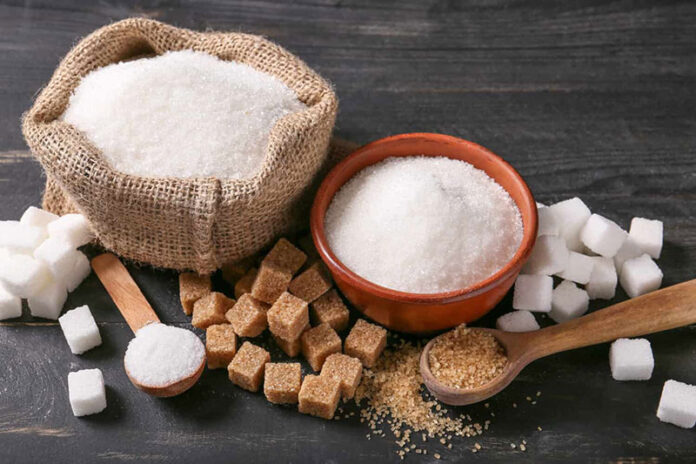Fructose is the form of sugar found in most fruits and certain vegetables and in natural honey, and can be part of a nutritious diet. But fructose is also a component of sucrose, the table sugar we use daily, where it makes up nearly 50 percent of the content. The other 50 percent of sucrose is composed of glucose, which is the main source of energy for the body.
In addition, fructose is also a component of high-fructose corn syrup (HFCS), which is manufactured from corn starch and added as a sugar substitute in many processed foods and drinks. HFCS contains up to 55 percent fructose, and if a product label lists ‘added sugar’ as one of its main ingredients, it is most likely to be high in fructose.
The main difference between HFCS and table sugar is that the fructose in HFCS is free molecules, so is absorbed rapidly into the body. As global diets have changed in recent decades, there has been an increase in the consumption of calorie-rich foods high in fat and free sugars such as fructose.
Doctors have long considered that the fundamental cause of obesity is an imbalance of calories consumed and calories expended. However, new research suggests that at the core of obesity may not be just an energy imbalance, but also where that energy comes from.
Researchers behind the new study explain that unlike glucose which is used as immediate fuel, fructose triggers the body to store fuel. While every cell in the body can use glucose as a source of immediate fuel, the liver is the only organ that can metabolize fructose in significant amounts. When people eat a diet that is high in calories and high in fructose, the liver gets overloaded and starts turning the fructose into fat.
Normally, mitochondria, the energy producer in cells, generates adenosine triphosphate (ATP), the molecule that provides energy to power all cell processes, by oxidizing the glucose found in cells.However, fructose lowers ATP concentration in cells and reduces the ability to make more ATP. When ATP levels drop enough, this sets off a series of chemical reactions that stop the mitochondria from producing more ATP, which leads to oxidative stress.
As well as causing ATP levels to drop, ingestion of fructose stimulates further food intake. These extra calories are then stored as fat. Eventually, the ATP levels increase again, but the stored fat remains. Over time, repeated oxidative stress leads to permanent mitochondrial dysfunction.
Unless intake of calories is reduced, this lower energy usage results in weight gain and obesity, which is a major risk factor for a number of chronic diseases, including cardiovascular diseases such as heart disease and stroke. Being overweight can also lead to diabetes and its associated conditions.
Some of the deleterious effects of consuming fructose in the form of added sugars are that it may:
- Impair the composition of your blood lipids. Fructose may raise the levels of very low-level lipoprotein (VLDL) cholesterol, leading to fat accumulation around the organs and potentially heart disease
- Increase blood levels of uric acid, leading to gout and high blood pressure
- Cause deposition of fat in the liver, potentially leading to non-alcoholic fatty liver disease
- Cause insulin resistance, which can lead to obesity and type II diabetes
- Fructose does not suppress appetite as much as glucose does. As a result, it might promote overeating.
- Excess fructose consumption may cause leptin resistance, disturbing body fat regulation and contributing to obesity.
While experts agree that high intake of fructose could be one component that leads to obesity, they add that it is not the only factor. Obesity is considered a multifactorial condition arising from various risk factors, including lack of physical activity, poor lifestyle (smoking, alcohol, addictions), poor nutrition intakes, vitamin deficiencies, socio-economic causes, and even genetic and ethnicity risk factors.
It is also important to realize that all of the negative connotations attributed to fructose found in HCFS and table sugar do not apply to whole sweet fruits that contain fructose. Fruits are foods with a low calorie density and lots of fiber. Moreover, most people do not overeat fruits, and a person would have to eat very large amounts to reach harmful levels of fructose.
In addition, fruits contain other health promoting elements such as vitamins, minerals, and fiber, none of which comes from added sugars we regularly use. In general, fruit is a minor source of fructose in the diet compared to added sugars. For example, one large apple contains about 2 grams of fiber and 22 grams of sugar, of which 13 grams are fructose. On the other hand, one large can (470ml) of a soft-drink contains 0 grams of fiber and 52 grams of sugar, 30 of which are fructose.
The biggest risk comes when the fructose is highly concentrated and added to other foods that often contain high fat, high sugar, low nutrients, which could lead to an increased risk of obesity. So, before you reach out to grab that processed snack or a can of soda loaded with fructose, ask yourself whether the momentary indulgence is worth the unhealthy weight gain it could spur, or the increased risk of developing obesity.

















